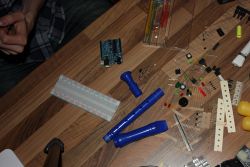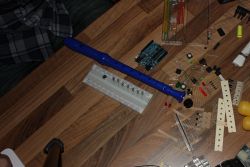| Line 78: | Line 78: | ||
* Foto oder Video der Ausgangslandschaft | * Foto oder Video der Ausgangslandschaft | ||
* Rasterform (Drei- oder Viereck) für Tracking | * Rasterform (Drei- oder Viereck) für Tracking | ||
== [[Hyun Ju Song]]: a dancing panty hose 'Dancerizer' == | == [[Hyun Ju Song]]: a dancing panty hose 'Dancerizer' == | ||
Revision as of 16:32, 30 May 2010
Projects from the course Breaking the Timeline, a Fachmodul by Max Neupert, Gestaltung Medialer Umgebungen Summer Semester 2010:
Kyd Campbell:
concept
I'm interested in exploring time-related breaks between the senses of sight and hearing. I believe there is a sensory gap when one moves in perception between the spaces of micro and macro. In this instance, time and sound are stretched, as the body adjusts to receiving intense macro detail. A journey/passage from one time/space environment to another is an overwhelming experience, a momentary loss of one's self into an aesthetic space, which may be considered cathartic.
In my work I wish to turn this phenomena into a public experience. It is my goal to produce the conditions, in a performance/screening setting for the audience to feel lost in the aesthetic space between micro and macro. I will use HD video images in micro and macro visions and unique techniques for recording motion. In the final work I will move rapidly between different image positions and search to bring and then hold the audience into a hyper-sensory experience.
I will take a minimal approach to sound, reminiscent of breath and focusing on silence to imply motion and change, remaining abstract.
The imagery will be taken from nature, outdoors and animals in very high resolution.
process
Collaborators please!~~ any feedback is more than welcome!
I must think about the image processing; sound and also the screening format (single channel or multiple monitors; screening/performance setup or installation; large or small)
I'm undecided how I want to proceed technically. As described above, I have the idea to create a certain atmosphere for viewers, to move then into a perception gap. I have some stock footage or HD video, chopped into very small clips and I would like to begin by inserting this into a large amount of different softwares (or hardwares) to see what effects can be achieved.
- if anyone is intested, I would really love to make a workshop session where different epople from the course take this footage and stick it into the different processing or editing tools they are familiar with, to see differents perceptions of the moving images I have.
- is this something we could do together in class for an hour or so? Is anyone interested? Should we set-up an additional session for it?
- possible tools to check out: different Pd patches, different editing softwares and filters, trying to watch it on different projectors, multiple monitors, self-made patches, specialized slow and fast motion HD plugins... I'm really open at this stage to try the footage out in any setting.
Andreas Beyer: Prosody
the keyword for this projekt is "prosody", that means the science about rhythm, stress and intonation of speech. I'll try to manipulate any given speech with a specific overlay to generate a new meaning or a strange combination of content and meaning e.g. reading the telephonbook like a holy speech and so on. The "overlayed" "structure" is given by the performer and the imput will be live. I want to realize this with a pd patch that i have to write or build till the semester. The background is a theorie that any kind of speech independent from the cultural background could be identified by anybody because of the intonation, the speech, the pitch (political, religious, news, sport, and so on) - this instrument could be used as a "translater" of the cultural melody of the voice or just to play with different meaning. It is the other way around how an anchorman works, he is trying to speak any typ of news in any combination more or less neutral - this is more difficult than it sounds.
Anja Erdmann:
- in this class i will get to work on "Schatten->Klang"
Dominique Wollniok:
Konzept
Idee:
In einem Raum kann man durch Bewegung Geräusche auslösen. Von einem Bild ausgehend, liegen die Geräusche in verschiedenen Ebenen. Durch mehrere Lautsprecher entsteht eine räumliche Klanglandschaft. Der Besucher erfühlt die akustische Umwelt und kann sie durch seine Bewegungen beeinflussen.
Ziel:
Ziel ist es eine akustische Topographie einer Landschaft auf ein sich im Raum befindliches Raster zu übertragen. Der Körper des Besuchers ist Auslöser der Geräusche. Inhalt ist das Zusammenspiel von akustischem Raum und dem Körper darin. Durch Reproduktion der Klanglandschaft in detailreiche Einzelgeräusche erlebt man eine Landschaft anders. Es entsteht ein anderer, interaktiver Zugang zur Landschaft.
Ton: Die Soundscape besteht aus der gesamten Geräusche-Umwelt und ihre Einzelheiten. Die Einzelgeräusche sollen so konstruiert werden, dass sie im Kontext zur gesamten Soundscape bestehen bleiben. Die Ton-Ausgabe geschieht über eine 5.1 Anlage.
Tracking: Ausgehend von einem nicht sichtbaren Raster auf dem Boden, werden bestimmte Sounds ausgelöst. Ist man weit vom Bild entfernt, nimmt man die Soundscape als Gesamtes wahr. Je näher man an das Bild herantritt, desto mehr bekommt man den räumlichen Eindruck vom Bild. Man geht sozusagen in das Bild hinein. Einzelne Geräusche werden durch entsprechende Positionen ausgelöst. Das geschieht über ein Tracking in x-y-Ausrichtung. Außerdem soll die Geschwindigkeit getrackt werden. Je langsamer eine Bewegung geschieht, desto länger soll der Übergang von einem Geräusch ins andere sein.
Anstehende Tests:
- Geräusch-Selektion einer Soundscape
- Lautsprecher-Aufstellung
- Foto oder Video der Ausgangslandschaft
- Rasterform (Drei- oder Viereck) für Tracking
Hyun Ju Song: a dancing panty hose 'Dancerizer'
A panty hose dances to the music.
For instance, like visualizer. In the visualizer, digital images follow the music. And in the dancerizer, the motions follow the music.
principle : A panty hose has two strings on either side of its upper part. These Strings are connected to the motors. When user selects and starts the music, then software analyzes the music and send the bit's signal to the motors. A panty hose dances some patterns of motion to the music.
Jeffers Egan:
Theory
Viewing Live AV as a platform for experimentation, my live sets explore the inscription of visual culture in time. By utilizing custom algorithms and animation software and without the use of prerecorded video or still footage, these works result in a hyperreal fluidity of visual mutations, ranging from tightly synchronized passages, to moments of free improvisation. Developing the concepts of digital as organism and software as ecosystem, my sets create a focused, personal aesthetic, finding commonalities in tone, texture and movement between audio and visual elements.
Practice
I have been invited to perform Live Visuals with vidderna, at ROJO/NOVA, a multimedia event this July in São Paulo, Brazil. We will play a 1 hour show together at an event alongside other AV acts.
Technically I am building a visual instrument in Touch Designer, . For the performance with vidderna, I plan to add a HD multi-movie stream compositing system(with alpha), a 3D timeline, and build/consolidate some GLSL shaders into 2D filters I can use in the compositing system.
I will also create new artwork specifically for this performance.
Matthias Breuer: Deconstructing the truth
Besides doing some research and experimenting I am trying to do one smaller project.
The project focuses on the truth and reality of the images we see. Taking any kind of video source as input, the stream's audio channel is continously played back. The corresponding frame is calculated from similarity to all previous frames. The most similar frame will be displayed. Each new frame is then placed in a database for comparison with forthcoming frames. This creates a steadily growing and learning mass which—after some time—can replace reality with frames from the past. At that point no clear distinction between reality and fiction can be made anymore.
Similarity between frames depend on an amount of chosen factors. Most commmon are histogram, structure etc. but always depend on the features one sees as important in an image. It's not important to match the look of a frame as close as possible but to match a frame in a given set of interests.
Maureen Anderson: Ulysses
The Starting Point
James Joyce spent 13 years writing a story that takes place on June 16, 1904, the day he met his future wife. The product of his attempt to depict the haphazrdness, among other things, of turn of the 20 century Dublin is one of the most highly structured works of modern fiction consisting of 265,000 words and a lexicon of 30,030 words covering a broad range of English, foreign, and invented words and sounds.
The Experiment
I will be working with speech-to-text dictation software to re-write Joyce's Ulysses by reading it unabridged on June 16 this year. Though many current dictation software is quite accurate, Joyce's lexicon and sentence structure all but defies an "accurate reading," meaning a new text is impossible to avoid. And though the story takes place in a twenty-four hour period, it's dense literary form requires roughly a day and a half to read out loud straight through. By remaining faithful to a time line, I hope to break it.
Natercia Chang: Mutually Intelligible
Background
- I remember the first few meetings and classes when I got here last semester, they were all in German. And without any knowledge in the German language, it sounded like noises to me and I started making up the content when they talked. The initial idea that I came up was to film some of the lectures and edit subtiles on the images, which would be totally unrelated to the acutal content that they were discussing.
- I have been attending lectures and workshops that are held almost entirely in German. To me, sitting in a classroom for more than 6 hours and listening to something not comprehensible at all is kind of a torture. Similarily, I am also interested to find out how would a person feels when he/she is forced to listen to something not in his/her first language.
- The expereince of watching movies here in Germany is pretty hard because most of the movies, they are synchronised with German language instead of screening the original audio version.
Concept
- Select a (or some) German movies and extract some of the scenes and/or shots without the audio
- Select a collection of foreign movies and extract the audio (dialogue) from some of the scenes and/or shots
- Synchronise the extracted images and audio and export it as a short video
- Create a booth that contains monitor and keyboard buttons that one can select languages (no German available) for viewing the video.
(I do not know the technical parts to build a booth with sensory buttons...)
Sebastian Wolf: VideoFlute
Those were two rather rough concepts waiting for more detail work.
- a video-controlling musical instrument, a digital flute
- ldrs controlling pitch/color channels or triggering specific scenes (there's an infinite number of possibilities actually)
- a microphone manipulating loudness/brightness/speed of the video or so
I think I will stick with the instrument-idea, starting with some Arduino-/electronics-/sensor- experiments and some research on how a real flute actually works, how the sound is produced and what the possibilities to control those sounds are. The mapping in Pd will probably be the most tricky part, so I will have to work on that simultaneously.






